PRODUCT SUSTAINABILITY Sustainable materials Dell prioritizes the use of recycled and renewable materials in both products and packaging. Recycled and renewable materials can dramatically reduce the environmental impact of manufacturing when compared to the emissions generated to create new materials. Our extensive work to scale our use of sustainable materials means we are not reliant on one material or supplier to reach our goal to have 50% of our products and 100% of packaging made with recycled or renewable materials by the year 2030. Recycled material we are using today: Renewable materials we are using today: • Closed-loop: Taking back out-of-use technology and recycling materials to • Bioplastics made with tall oil: A by-product of the paper-making process, make parts for new devices. For example, in 2021 OptiPlex became the first tall oil37 is mixed with other new and recycled materials for use in the lids of PCs to use hard drives made with closed-loop recycled aluminum sourced Latitude 5000 and Precision 3000 notebooks. Dell Latitude 5000 series 36 from old disk drives. 38 • Bio-based rubber using castor oil: A nonfood crop, castor oil is used • Carbon fiber: Recycling carbon fiber materials sourced from the aerospace to create a rubber material for the bottom bumpers on new Latitude The new Dell Latitude 5000 series products and other industries for use in our products. This thermoplastic carbon 5000/7000/9000 series laptops and in Precision 3000 series mobile are made with the industry’s most innovative fiber-based material can be ground up, remelted back into thermoplastic workstations laptops. use of sustainable materials in mainstream resin and molded into new parts, while maintaining its recyclability. • Renewable packaging materials: Recycled corrugate and paper, bamboo, business laptops with recycled, reclaimed and • Ocean-bound plastic: Since 2017, we have used over 443,000 pounds of and most recently, bagasse, a sugar cane byproduct, are materials we use in renewable materials throughout the chassis. ocean-bound plastics in our packaging. We recently extended use of this select packaging. List of sustainable materials: material in select Latitude, Precision and OptiPlex products, as well as our EcoLoop™ line of carrying cases. • Laptop lid – 71% PCR plastic, reclaimed 39 • Post-consumer Recycled (PCR) Plastic: We use PCR plastic made from a carbon fiber and bio-based plastic variety of sources, such as 5-gallon water cooler jugs and single use plastics • Palm rest – 35% PCR plastic across our product and packaging portfolio. • Inner frame – 35% PCR plastic We also look for materials that have as little carbon footprint as possible in production, assembly or transportation. Our work with aluminum is a great example. • Battery frame – 50% PCR plastic Traditionally, aluminum has a high carbon footprint due in large part to the smelting process, which typically occurs in coal-powered facilities. To help reduce • LCD cover frame – 30% PCR plastic carbon footprint, our XPS 13 Plus chassis is made with aluminum produced with hydropower. This chassis offers a 70% reduction in carbon emissions versus a • AC adapter exterior – 30% PCR plastic coal–powered chassis. We will extend this material to additional product lines in 2022. • Fan-housing – 28% ocean-bound plastic • Laptop base – 20% reclaimed carbon fiber • Rubber feet – up to 39% bio-based rubber INTRO OUR PLAN GOALS DASHBOARD ADVANCING SUSTAINABILITY CULTIVATING INCLUSION TRANSFORMING LIVES ETHICS & PRIVACY SUPPLY CHAIN BY THE NUMBERS APPENDIX DELL TECHNOLOGIES 65 FY22 ESG REPORT
 Our purpose in action | Dell Page 64 Page 66
Our purpose in action | Dell Page 64 Page 66